Craft a Winning Strategy with the Perfect Persona Template
- Home
- Craft a Winning Strategy with the Perfect Persona Template
Imagine you're about to paint a masterpiece, but instead of brushes and oils, your tools are data points and insights. That's the art of crafting a buyer persona template. In the world of inbound marketing, It’s like sketching out the perfect character for a novel that’s bound to become a bestseller in business-to-business marketing.
The strokes on this canvas reveal more than just basic outlines; they colour in your customer persona's personality traits, pain points, and aspirations. You get to step into your customer's shoes, understanding their needs and why. This isn't just theory; it's practical magic at work.
Dive deep with me as we explore how these personas breathe life into user experience design and align laser-focused with B2B marketing objectives. By the end of our journey together, you'll have unlocked valuable insights to connect better with your ideal customer—creating campaigns that resonate profoundly because every decision is informed by real-world context.
Table Of Contents:
- Understanding the Persona Template in B2B Marketing
- Crafting Your Buyer Persona with HubSpot's Tools
- Gathering Data for an Accurate Customer Profile
- Implementing Inbound Marketing Methodology with Personas
- 5 Steps to Creating Effective User Personas
- Analyzing Behavioral Insights from Your Target Audience
- Leveraging User Personas for Content Strategy
- Maximizing Campaign Results with Buyer Personas
- Real-world Applications Examples of Successful User Personas
- Refining Your Persona Templates Over Time
- FAQs about Buyer Persona Templates
- Conclusion
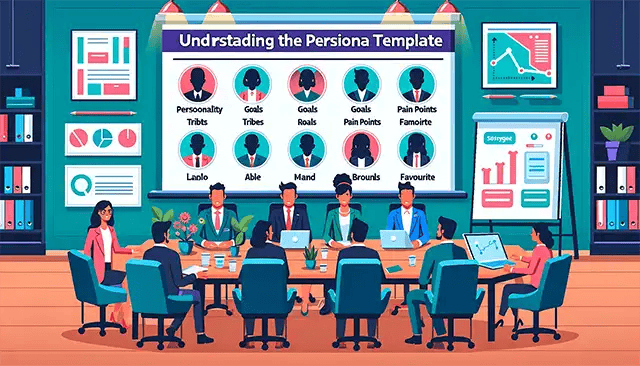
Understanding the Persona Template in B2B Marketing
Imagine entering a room full of potential clients with unique business needs and preferences. This is where a user personas template becomes your secret weapon, allowing you to tailor conversations that resonate on an individual level—even when dealing with other businesses.
Defining User Persona Templates
A user persona template is like a character sheet for Dungeons & Dragons—but instead of fantasy adventurers, they're profiles of your ideal customers. They go beyond job titles and industry types to create actionable personas; these comprehensive sketches highlight personality traits, goals, pain points, and even favourite brands.
It's not just about who may buy from you but why they would choose to do so.
User personas are vital tools across UX design processes and product development discussions because they keep customer experience at the forefront. For marketing teams, user personas are gold mines for crafting messages that hit home.
The Role of Buyer Personas in B2B Marketing
In the chess game that is B2B marketing in the UK—or anywhere—buyer personas represent your pawns turned queens: indispensable players guiding strategy moves from opening gambits to checkmate closures. By understanding target markets through buyer personas' lenses, HubSpot’s free tools help teams create detailed dossiers, ensuring every campaign move aligns perfectly with client expectations.
Beyond simple demographics or firmographics lies a more profound layer essential for connection—a mix of LinkedIn insights and Sunday pub chatter—that includes values specific to decision-makers within organizations one aims to partner with or sell services/products to.
Here, we aren't just selling widgets; we're building relationships based on trust fostered by mutual understanding enabled via meticulously crafted buyer personae reflective of genuine potential buyers' journeys—from first awareness touchpoint down conversion funnel paths towards loyalty loops akin to personal friendships rather than transactional interactions typical cold corporate environments tend depersonalize over time otherwise left unchecked without such robust profiling mechanisms place guide efforts effectively efficiently maximizing ROI end day, after all, isn't what it's ultimately about?
Persona templates are your ace in the hole, letting you start conversations with potential B2B clients by understanding their unique traits and needs.
User personas aren't just profiles; they're the heart of crafting messages that resonate deeply, keeping customer experience centre stage in marketing strategies.
In B2B marketing's strategic game, buyer personas are key players that help shape successful campaigns and build trust through a deep connection beyond mere transactions.
Crafting Your Buyer Persona with HubSpot's Tools
Imagine having a compass that points you directly to your ideal customer’s deepest needs and desires. That's precisely what crafting a buyer persona can do for your B2B marketing efforts, especially when using HubSpot's nifty tools.
Using HubSpot's Persona Generator Effectively
HubSpot has launched a persona generator to help marketers easily create detailed buyer personas. The tool is intuitive and leverages marketing data to shape the characters representing potential customers. To get started, you'll need some background info on those most likely to buy from you.
The key is blending demographic information like age and occupation with psychographic details such as goals and challenges—think of it as creating an avatar for each audience segment.
But don't stop there; throw in behavioural patterns, too, because how they interact online tells us about their purchasing decisions.
Digging into these layers helps product teams develop offerings tailored just right—and ensures UX designers hit all the sweet spots user experience-wise. And here’s something juicy: Did you know HubSpot’s freebie lets you build multiple personas? So whether it’s Steve, the Startup Owner, or Enterprise Emma, everyone gets a seat at the table.
Gathering Data for an Accurate Customer Profile
Your quest begins by collecting gems of data—sparkling insights that reveal who wants what you're selling. It sounds like detective work because it is. Combining bits of the demographic scoop with slices of behaviour gives life to more than just numbers—it paints pictures we call buyer personas.
This isn’t guesswork; it calls for Sherlock-level sleuthing across social media chatter, past sales interactions, and even surveys if needed. Remember, though, that quality trumps quantity whenever gathering intel on our future brand advocates.
Implementing Inbound Marketing Methodology with Personas
Inbound marketing methodology whispers sweet nothings into leads’ ears along their customer journey—but only if we speak their language. User personas become our Rosetta Stone here; they guide content creation so messages resonate loud and clear without getting lost in translation (or worse—in spam folders).
- A good user persona acts like GPS navigation through content strategy territory;
- Social media becomes less shouty megaphone and more engaging conversation starter;
- You can almost hear the click-through rates climbing while bounce rates dive.
Use HubSpot's Persona Generator to craft detailed buyer personas that mix demographics, psychographics, and online behaviours. This deep dive helps tailor products and UX designs, while their free tool lets you create multiple avatars like Steve, the Startup Owner or Enterprise Emma.
Gather data through social media, sales history, and surveys to build accurate customer profiles—not just guesswork but real detective work for identifying your brand advocates.
User personas are crucial in inbound marketing. They ensure that content speaks directly to leads' needs, turning social media into meaningful dialogues and significantly boosting engagement metrics.
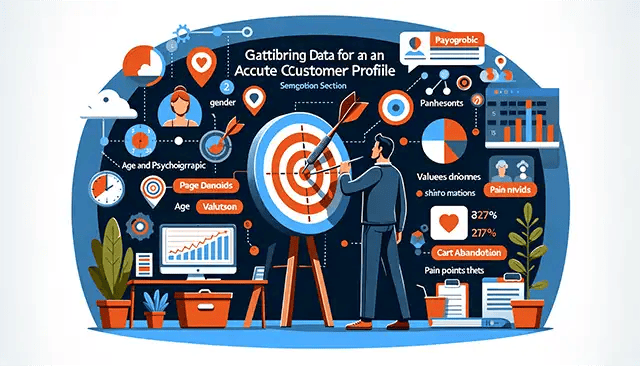
Gathering Data for an Accurate Customer Profile
Picture a dartboard where every section is a different customer. Wouldn't it be something if you could hit the bullseye each time? That's what gathering the correct data can do for your customer profile—it sharpens your aim.
Combining Demographic and Psychographic Information
First, get to know your customers, including demographics, age, gender, and location. But that’s just one piece of the puzzle. Psychographics bring in personal details like values and opinions. Together, they’re like salt and pepper; sure, they're great alone, but together? Chef's kiss.
The key stats don’t lie: when these two types of information waltz together seamlessly, buyer personas come alive with rich detail that makes them practically jump off the page.
Finding Your Ideal Customer Through Behavioral Data
Now, let’s talk about behaviour because actions speak louder than words. In this case, we need examples of user personas and data points. Track how users interact with your site or product. For a UX persona, do they linger on certain pages? Abandon carts after seeing shipping costs?
This behavioural insight lets you tailor experiences to better meet their needs because you’ll understand who they are and what makes them tick—and click.
Pain Points: The Not-So-Secret Ingredient
Your ideal customer has struggled—you've got solutions. Identifying pain points means listening closely through surveys or social media chatter and becoming their problem-solver extraordinaire.
A good user persona template weaves these challenges into its narrative so everyone, from UX designers to marketing mavens, knows precisely which dragons need slaying.
By the way, HubSpot's Persona Generator is perfect for fleshing out these finer details without much work.
Add Relevant Details Without Cluttering Your Canvas
You'll want those favourite brands listed alongside the most common communication channels.
This paints a full-colour picture rather than leaving you with some beige outline of 'generic businessperson #7'.
When done well—with all due diligence paid to collect meaningful data—a finely-tuned customer profile template stands ready at bat, swinging straight toward that sweet spot between effective strategy and genuine connection.
Gather the right mix of demographic and psychographic data to nail your customer profile. Watch their online behaviour, spot their pain points, and then swoop with solutions. Use tools like HubSpot's Persona Generator to add colour without clutter for a persona that connects and converts.
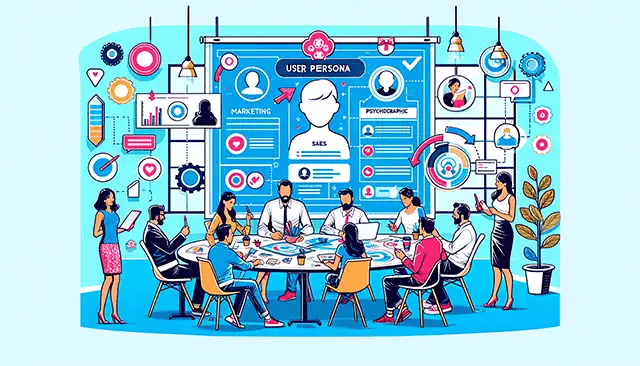
Implementing Inbound Marketing Methodology with Personas
Suppose you're knee-deep in the marketing game. In that case, you know that inbound marketing methodology isn't just a buzzword—it's about attracting customers through content and interactions that are helpful and relevant. And guess what? User personas are like the secret sauce to making it all click.
The Synergy of Buyer Personas with Lead Generation
Baking buyer personas into your lead generation efforts is akin to using grandma’s secret recipe for Sunday dinner – it perfectly combines everything. When you craft user personas based on solid research, they become more than flat profiles; they’re blueprints of your ideal customer's world. With these detailed guides, every piece of content you create is laser-focused, talking directly to their needs and pain points—like an old friend who knows just what to say.
To get there, though, creating user personas must be intentional. It’s not enough to slap together demographic info and call it a day. You’ve got to dig deep into behavioural data, too, because, let’s face it: people aren’t robots (not yet, anyway). What drives them?
Where do they hang out online? Which cat videos make them laugh so hard they forget about work? These insights can give your inbound strategies legs—and we mean Usain Bolt kind of speed—to reach those lead-gen goals faster.
Crafting User Personas That Resonate
We've seen our fair share of persona templates around here—they range from bare-bones basics to War-and-Peace-level epics—but striking gold means hitting somewhere in between. Your user persona guide should have enough meat for team members across product development or UX design roles, but it should also stay lean enough not to scare off busy marketers who need this stuff.
So when building out these handy dandy cheat sheets for understanding target users better than their mothers do (okay, maybe not quite), start by asking yourself: "If my ideal customer were a sandwich, what kind would they be?" Strange analogy aside—that's how specific we want these details. Include demographic slices like age or job title sure—but don’t skimp on the spicy mustard either; add relevant psychographic tidbits such as values or hobbies too.
User Persona Creation As A Team Sport
Gathering everyone around the proverbial campfire—or Zoom meeting—for some good old-fashioned collaboration makes crafting effective personas less daunting.
Encourage input from different departments since sales folks will bring juicy tidbits from conversations with actual leads, while UX designers might offer valuable insights gleaned during usability testing sessions.
And remember—personality traits matter big time here. Maybe 'Accountant Anne' is more than just a number cruncher. Thanks to her analytical skills and attention to detail, she could be your secret weapon in strategic planning. It's all about playing to each team member's strengths.
Think of user personas as your marketing's secret sauce—they're not just profiles but blueprints that let you speak directly to your customer's heart.
To craft them right, mix demographic details with spicy psychographic insights and get the whole team involved to create a persona that resonates.
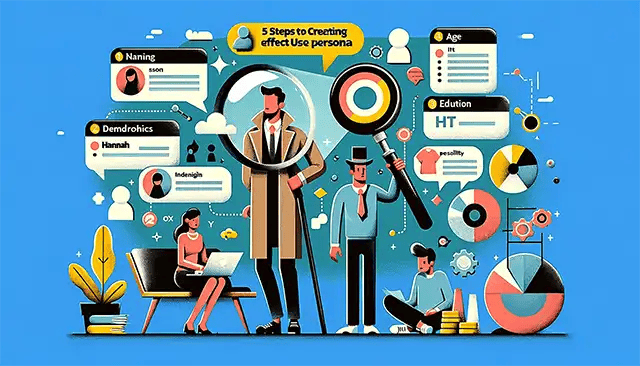
5 Steps to Creating Effective User Personas
Imagine you're a detective, piecing together clues about your ideal customer. Creating buyer personas is like that—it’s a mission to uncover your target audience's who, what, and why.
Naming Your Persona
A name does more than identify; it brings your persona to life. Start creating personas by choosing a name that reflects the character of your persona profile - think 'HR Hannah' or 'IT Ian', giving them an identity beyond data points. This personal touch helps team members remember that they’re designing for real people with unique needs and preferences.
Add a photo next. This visual cue solidifies HR Hannah's reality in everyone's minds as they craft marketing campaigns tailored just for her. It turns abstract demographics into someone we feel like we know personally.
Outlining Demographics
The skeleton of any reasonable user persona includes demographic details—age range, job title, industry sector—but don't stop there. Add relevant layers by including education level or favourite brands. These tidbits offer insight into lifestyle and values, which is gold when crafting targeted content strategies.
Your ideal customers aren’t faceless entities but fleshed-out characters with backgrounds influencing their decision-making processes. By understanding their day-to-day lives through these demographics, you’ll create detailed narratives that guide product teams towards solutions that resonate deeply on both professional and personal levels.
Identifying Key Traits
We've named our persona and outlined their background; now, let’s get inside their headspace to pinpoint personality traits impacting how they interact with products or services within UX design scenarios or social media platforms. Are they risk-takers? Do analytics drive them?
- Analytical Andy might pore over specs before making decisions, while compelling stories behind each feature could sway Spontaneous Sophie.
- Diving deeper into psychological factors equips us with empathy toward users’ challenges and primes us to ideate innovative features that are perfectly aligned with users' expectations.
This clarity paves the way towards intuitively constructing experiences that customers can't help returning time after time. Weaving these traits throughout every aspect, from UX user interface elements to even the most minor email communication, ensures consistency across all channels, engaging buyer personas effectively.
With this knowledge, build out fully realized portraits, complete goals, frustrations, motivations, and crucial behaviours, ensuring inbound marketing efforts hit the mark exactly where needed and, most importantly, exponentially increasing lead generation success rates.
Give your personas names and faces to make them real for the team. Flesh out their lives with demographics and traits so you can craft strategies that hit home and boost lead generation.
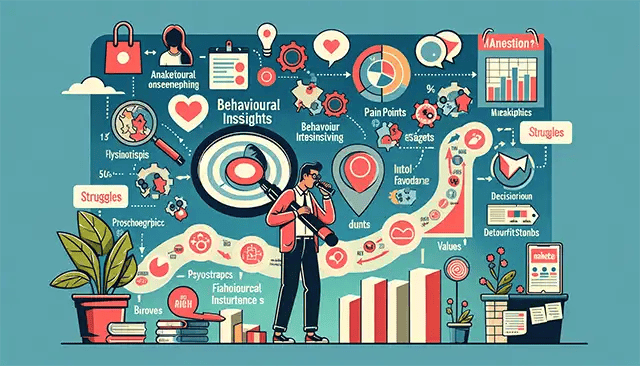
Analyzing Behavioral Insights from Your Target Audience
When you get down to it, the core of inbound marketing is about understanding your target audience like they're an open book. To make that happen, analyzing behavioural insights becomes a non-negotiable task. Let's say goodbye to guesswork and hello to data-driven strategies.
The Goldmine of Data: Pain Points and Customer Journey
Gleaning valuable insights starts with identifying pain points—those frustrating problems that keep your ideal customers awake at night. Imagine having X-ray vision into their daily struggles; this is what behavioural analysis offers. You'll need more than surface-level info; diving deep through surveys or social media can reveal these gems.
Next, map out the customer journey—from awareness to decision-making. It’s like being a detective on a stakeout; observing how potential buyers interact with content gives clues on optimizing every touchpoint for better engagement.
Digging Deeper: How Understanding Persona Enhances Insight
To truly understand persona nuances, you must peel back layers beyond basic demographics—you’re after psychographic gold here. Think hobbies, values, and favourite brands—all those tidbits paint a picture of who you're talking to and why specific messages resonate more than others.
Asking questions helps, too. "What drives our users?" "Which channels do they frequent?" By answering these inquiries with data-backed evidence, tailoring communications suddenly feels less like throwing darts in the dark and more like precision archery.
Leveraging Insights for Real Impact
Taking these juicy bits of information isn't just an academic exercise—it has real-world implications for dramatically sharpening your marketing campaign’s effectiveness. Crafting messaging that hits home means turning bland statistics into vibrant stories about people with unique needs and desires.
You've got powerful tools like HubSpot's Persona Generator, which lets marketers easily create detailed profiles without breaking a sweat (or budget).
These aren’t static either; as behaviours shift or new trends emerge, revisit them often so they always reflect current realities rather than past assumptions.
In summary? Remember Sherlock Holmes saying, “Data. Data. Data.” He couldn’t make bricks without clay—and neither can you when building solid user personas focused squarely on actual human beings behind screens seeking solutions only YOU can provide... if you’ve listened well enough through careful behavioural insight analysis.
Dive into your audience's world to nail inbound marketing. Analyze their behaviours, identify pain points, and map their customer journey like a detective for spot-on engagement strategies.
Peel back the layers of your personas by looking at hobbies and values—this psychographic gold sharpens communication like precision archery.
Use insights to craft messages that resonate deeply. Tools like HubSpot's Persona Generator keep profiles fresh and reflect current trends—because, in marketing, data is as crucial as clay is to bricks.

Leveraging User Personas for Content Strategy
Imagine you're a chef. Your user personas are the ingredients, and your content strategy is the dish you're about to whip up. To get it just right, each ingredient must be chosen carefully to appeal to the taste buds of your ideal customers.
The Impact of Good User Persona Templates on Targeted Content
Good user persona templates do more than sit pretty in marketing meetings; they guide every content you create. When done well, these blueprints mirror the interests and needs of those who matter most—your audience. They tell you what problems your target market faces so that your blog posts can swoop in as solutions faster than a superhero.
A good persona outlines everything from demographic details to favourite brands, turning vague notions into clear pictures of who's buying or might buy what you sell. But remember: static profiles collect dust while dynamic ones evolve with insights gleaned over time.
Crafting Personalities That Resonate With Social Media Savvy
Social media isn't just cat videos and memes—it's where personalities shine and interact daily. By infusing personality traits into personas that resonate on social platforms, we don’t guess our way through campaigns; we navigate with precision.
We see this play out when crafting messages for LinkedIn professionals versus Instagram influencers—the tone shifts because their worlds differ significantly. So, let’s tailor our strategies accordingly because no one enjoys receiving a formal business proposal when scrolling through beach vacation photos.
User Experience Design Meets Marketing: A Match Made in Heaven
In UX design circles, there's chatter about how knowing users leads to better product teams' decisions—and they’re spot-on. When marketers adopt this mantra too by aligning content with meticulously researched buyer personas—we start seeing things click together like Lego bricks building an empire (of satisfied customers).
Your team understands not only 'what' but 'why', allowing them to craft stories that connect deeply—because now they know exactly whose heartstrings they’re tugging at.
Now, roll up those sleeves. It’s time for some hands-on work.
Gathering Behavioral Insights Without Playing Detective
Let me give it straight—digging deep into customer journeys reveals pain points sharper than stepping on Legos barefoot.
When we listen closely enough, though, we uncover gold mines filled with valuable insights, leading us towards messaging that isn't missed.
Because hey—who wouldn't want their brand narrative hitting home runs instead of foul balls?
And here comes data riding its white horse.
Consider the ergonomic design of our combs to ensure seamless integration with your daily routine. They're crafted for comfort and efficiency, and we've thought through every detail so you don't have to deal with any tangles or discomfort during use.
Think of user personas as the secret sauce that makes your content irresistible to your audience. They're dynamic tools that evolve with real insights and guide you in crafting messages that hit home—whether it's a LinkedIn article or an Instagram story.
Listening to customer journeys is like striking gold, providing sharp insights for spot-on messaging. Dive into behavioural data and let those findings shape narratives that resonate deeply and drive satisfaction without any guesswork involved.
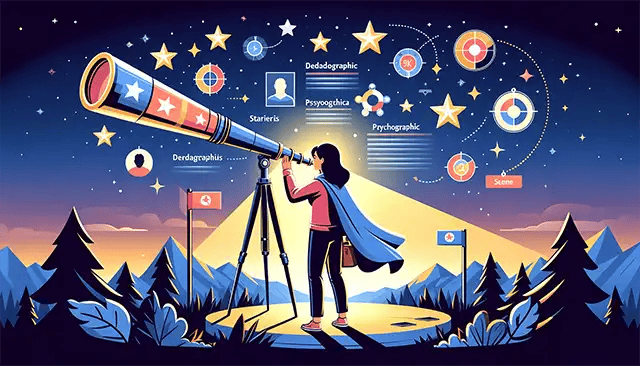
Maximizing Campaign Results with Buyer Personas
Have you ever felt your marketing campaigns were a shot in the dark? That's where buyer personas come into play, acting as your campaign's North Star. Picture this: instead of shouting into the void, you're having a one-on-one chat with your ideal customer—because you know exactly who they are and what makes them tick.
The Science Behind Persona-Driven Strategies
To put it simply, buyer personas are not just fancy dossiers; they’re crucial tools for product marketing that turn anonymous faces in a crowd into fleshed-out characters with desires and pain points. When discussing crafting these profiles perfectly, think CSI-level detail minus the crime scene tape. It would be best to mix demographic scoops with those juicy psychographic tidbits—the secret sauce that tells you why customers wake up at 3 AM craving solutions only you can offer.
Weaving this data together creates an accurate blueprint of your target market—one so spot on it might as well be clairvoyant. And here’s some food for thought: while content strategy is often hit or miss, injecting good user persona templates gives your purpose and direction.
User Personas Fueling Inbound Marketing Mastery
Inbound marketing methodology without user personas is like trying to complete a puzzle blindfolded—you could get lucky once or twice but wouldn't bet your bottom dollar on consistent success. Now imagine each piece represents valuable insights from understanding persona nuances which guide potential customers through their journey seamlessly—no hiccups allowed.
Better yet? These aren’t static cardboard cutouts—they evolve as trends do. Keep refining those profiles over time to ensure every campaign hits closer home than the last because, let’s face it, markets change faster than fashion trends (and no one wants to be caught wearing last season's fad).
Tangible Gains: Real-world Proof in Your Pudding
Doubting Thomas may ask for proof before believing in persona magic—and rightfully so. But rest assured; there’s plenty—a treasure trove of case studies showing companies that saw their engagement skyrocket thanks mainly to their meticulous application of UX design principles rooted deeply within user experience understanding.
HubSpot's Persona Generator, for instance, has been pivotal for businesses wanting to create detailed snapshots of ideal users quickly.
So when someone asks if integrating detailed buyer personas cranks up campaign results... Just give them "the look"—you know which one—and point towards all successful marketers, nodding yes emphatically.
Think of buyer personas as your marketing GPS, guiding you to connect deeply with customers by understanding their desires and pain points. With these detailed profiles, each campaign feels like a personalized conversation, not just a shot in the dark.
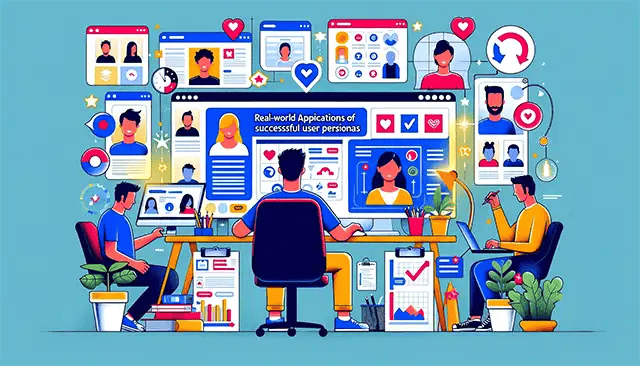
Real-world Applications Examples of Successful User Personas
Picture this: a UX designer sits at their desk, crafting the next big app. They're not just guessing who will use it—they know, thanks to good user personas that act like North Stars guiding every design decision. This isn't just make-believe; it's how top companies nail their target market and create products people love.
The Powerhouse Behind UX Design: Effective Persona Use Cases
User personas are more than fancy posters hanging on office walls; they’re strategic tools for empathizing with users. Take Airbnb, for example—a brand known for its exemplary UX design—where detailed personas help developers walk a mile in their users' shoes, leading to an intuitive platform where hosts and guests connect seamlessly.
Then there’s Spotify, which hits all the right notes by understanding examples of personas from music lovers worldwide. Their recommendation algorithm doesn’t just guess your taste—it knows you because the product team created spot-on user profiles through rigorous data analysis.
Influencing Content Strategy with Buyer Personas
Crafting content without buyer personas is like shooting arrows in the dark—ineffective and wasteful. With well-crafted user profiles, marketers can tailor messages that resonate deeply with each segment of their audience—an approach used by successful tech giants such as HubSpot itself.
Dive into HubSpot's Persona Generator, a tool many wield to define customer challenges and preferences accurately. It's about connecting the dots between what customers think and what they need—a technique perfected by companies using free user persona templates as foundational elements of any marketing plan.
Leveraging Insights From Detailed Demographics
Create accurate portraits of your ideal customers—that’s one key takeaway from examining industry leaders who've mastered UX design through persona creation. Adding relevant details such as favourite brands or media habits turns vague concepts into relatable characters that inform everything from social media campaigns to product features.
An effective example? Look no further than gaming powerhouse Blizzard Entertainment, whose keen insights into player behaviour fuel game development cycles and community engagement strategies that effectively cater to diverse gamer personalities across its portfolio of titles.
Remember, folks, creating strong buyer personae isn't some mystical art form reserved only for Silicon Valley elites—it’s a practical, step-by-step process accessible even to newcomers. Start building yours today, and watch how those fictional faces bring real profits tomorrow.
Use user personas to guide design and content strategies like top companies do. They help you understand your audience and tailor experiences they'll love—think Airbnb's seamless platform or Spotify's personalized playlists.
Dive deep into demographics to craft accurate customer portraits. Details matter—they turn vague ideas into relatable characters that drive successful campaigns and product features.
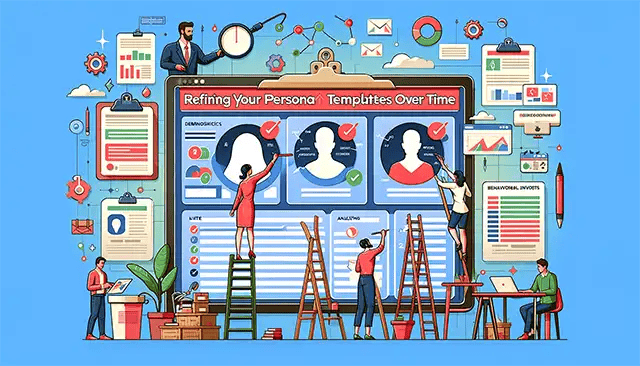
Refining Your Persona Templates Over Time
The market is a wild beast—constantly evolving and always shifting. If you're not updating your persona templates to match its movements, you might as well be shouting into the wind. Adapting profiles is like tailoring a suit; it must always fit perfectly for maximum impact.
To stay on top of this game, think of your buyer personas as living documents—they grow and change just like real people do. It's about keeping those sketches of ideal customers fresh and relevant in ever-evolving markets. So roll up your sleeves because we've got some fine-tuning to do.
Gathering Fresh Data: A Continuous Cycle
Fresh data keeps personas vibrant—and boy, does that pay off. As behaviours shift, so should the insights that shape our marketing blueprints. Look for new pain points cropping up or old ones fading away; these nuggets are gold when refining target audience portraits.
Surely you remember jotting down every demographic detail with glee when creating user personas? Well, don't let that excitement dwindle over time. Continue adding relevant information by conducting regular surveys or interviews and using social media listening tools to get the lowdown on what makes your audience tick today—not last year.
Analyzing Behavioral Insights Like Sherlock Holmes
Understanding persona requires playing detective with customer journey maps occasionally—you want valuable insights straight from the source. Watch how customers interact with content across different channels; where they linger speaks volumes about their interests and needs.
A keen analysis may reveal shifts in favourite brands or communication preferences—an email aficionado could now swear by instant messaging apps instead. Spot these trends early enough and watch how effortlessly campaigns resonate after incorporating such findings into your user persona's focuses.
Tweaking Personas Based On Campaign Results
Your campaign results aren't just numbers—they're whispers telling you how close (or far) you are from nailing down what truly resonates with target users. Analyze each outcome diligently; adjustments must be made if something's amiss within product marketing efforts.
HubSpot’s Persona Generator, though already quite handy during the initial creation stages, becomes invaluable here, too.
So, while sipping coffee tomorrow morning, ponder this: Who has my market evolved into lately? Then, get cracking at shaping those personas accordingly because nothing spells success like messages hitting home run after home run.
Keep your buyer personas as fresh as the market. Regularly update them with new data and insights to stay ahead of shifts in customer behaviour and preferences.
Treat persona development like detective work, using tools and analytics to adapt your marketing strategy for better engagement.
FAQs about Buyer Persona Templates
What is a persona template?
A persona template is a fictional character sketch representing your ideal customer, crafted to guide marketing strategies.
How do I create my persona?
To craft your persona, you must examine customer data and behaviours and mould those insights into a relatable profile.
What are the seven steps to create a persona?
The seven steps are to research customers, identify patterns in data, draft personas profiles, refine with team input, test against real interactions, and iterate as needed.
How do you write a persona example?
Pick key traits from customer segments. Write it up like you're introducing someone at a party – brief but vivid details make them stick.
Conclusion
Start with insight, shape your strategy, and connect deeply. A well-crafted persona template guides you there. It's about knowing who you're talking to and envisioning the user behind every click.
Step into their world; grasp what drives them in B2B landscapes. You've learned that personas are more than data—they embody hopes and hurdles.
HubSpot's tools help sketch these vital profiles, while demographics and psychographic elements give depth to each persona's story.
User experience hinges on this clarity; it directs product teams like a compass. Your marketing now mirrors real needs because it starts with genuine understanding.
The takeaway? Build user personas that resonate—a beacon for all your campaigns—and watch as connections become conversions.




